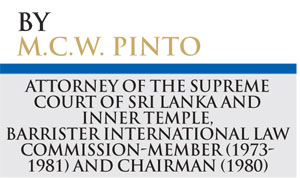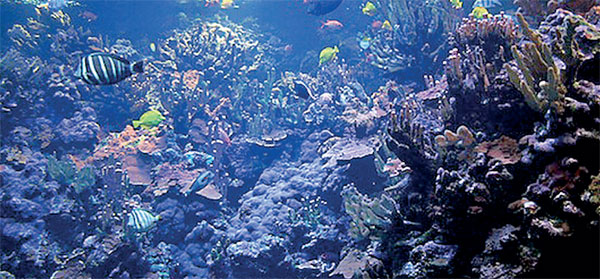.jpg)

.jpg)
n the decade of the 1960s, scientists reported that the bed of the deep seas could yield virtually limitless mineral wealth (see for example, J. Mero, The Mineral Resources of the Seas, Elsevier, Amsterdam, 1965). The main focus of interest at that time was concentrations of polymetallic nodules to be found on the surface of the sea-bed, or slightly below it, at depths of several thousands of metres. The nodules, grey-black lumps of varying size and composition, were estimated to contain, depending on their location, as much as 40% manganese, 4.6% nickel, 4.5% copper, and 0.9% cobalt, all – and in particular the three last named – being of substantial commercial interest. More recently polymetallic sulphides and cobalt – rich manganese crusts have been discovered. Although the richest known deposits are said to be found on the bed of the Pacific Ocean, polymetallic nodules are also located on the bed of the Indian Ocean South of Sri Lanka, and are already the subject of a pioneer investment by the Government of India.
Declaring the deep seabed with its vast mineral wealth to be “the common heritage of mankind” was the result of a grand vision born out of the ferment of ideas that emerged in that same decade of the 1960s, which also saw several countries regain their independence from colonial rule, and the formation of the Group of 77 at the UN Conference on Trade and Development in 1964. In May 1966, the Commission to Study the Organization for Peace, proposed the establishment of a specialised agency of the United Nations that would control and administer marine resources, hold ownership rights and grant, lease or use those rights. In July 1966, President Lyndon Johnson, when commissioning the research vessel Oceanographer, warned that the prospect of rich harvests and mineral wealth from the sea could create a new form of colonial competition among maritime nations, and urged that “the deep seas and ocean bottoms are, and remain the legacy of all human beings”. In July 1967, the World Peace through Law Conference at its meeting in Geneva referred to “the untold resources of the high seas and the bed thereof beyond the continental shelf” and observed that “the high seas are the common heritage of all mankind”. That Conference recommended to the General Assembly of the United Nations “the issuance of a proclamation declaring that the non-fishery resources of the high seas outside the territorial waters of any State and the bed of the sea beyond the continental shelf, appertain to the United Nations and are subject to its jurisdiction and control”.
In 1967, Ambassador Arvid Pardo, Permanent Representative of Malta to the United Nations, requested that a supplementary item be placed on the agenda of the General Assembly. That item proposed adoption of a Declaration and a Treaty concerning “The creation of an international agency (a) to assume jurisdiction as a trustee for all countries, over the seabed and the ocean floor beyond the limits of present national jurisdiction; (b) to regulate, supervise and control all activities thereon; and (c) to ensure that the activities undertaken conform to the principles of the proposed treaty.”

Pardo in his epic address to the U.N. General Assembly that extended across its 1515th and 1516th meetings on 1 November 1967, expounded his vision of the deep seabed and its resources as “the common heritage of mankind”, setting in motion decades of work on the Law of the Sea in general, and on that vision in particular.
Conceived in the decade of the 1960s, the idea of a “common heritage” immediately attracted support from the developing countries, many of them recently liberated from colonial rule and hopeful of supplementing their national wealth from an independent source. The industrialised countries, on the other hand, held back, arguing with some justification, that the “common heritage” concept was of “uncertain legal content”. With the developing countries in the lead, the General Assembly embarked in the decade of the 1970s on clarifying the legal content of Pardo’s concept, establishing an ad hoc Committee and later a standing Committee presided over by Ambassador H.S. Amerasinghe of Sri Lanka, commissioned to achieve that objective. Ambassador Amerasinghe enabled the General Assembly to take the first step envisaged by Pardo by presenting to it a draft Declaration of Principles Governing the Seabed and Ocean Floor, and the Sub-soil thereof beyond the Limits of National Jurisdiction. The Declaration was adopted by the Assembly at its Twenty-fifth Anniversary Session in 1970, by 108 votes in favour, to none against, with 14 (western and socialist) abstentions. At that session, the General Assembly also resolved to convene the Third U.N. Conference on the Law of the Sea, which met frequently throughout the coming decade.
The decade of the 1970s also witnessed a great ferment of other new and ambitious political ideas espoused by the Group of 77. The Declaration on the Establishment of a New International Economic Order was adopted at the Sixth Special Session of the General Assembly on May 01, 1974. The Charter of the Economic Rights and Duties of States was adopted by the General Assembly at its 29th regular session on 12 December 1974, by 120 votes in favour, to 6 against and 10 abstentions. It was a time of great confidence and expectation on the part of the developing countries based on the feeling of solidarity generated within the Group of 77. The content of both these documents directly inspired positions maintained by members of the Group in deliberations at the Third United Nations Conference on the Law of the Sea, 1973-1982.
The U.N. Convention on the Law of the Sea signed at Montego Bay on December 10, 1982 was the product of the longest and most complex international negotiation ever undertaken. It resolved technical, scientific, legal and organizational issues by agreed and transparent procedures aided by co-operative contributions from specialist members of over 150 delegations. At the eleventh and final Session of the Third U.N. Conference on the Law of the Sea, on 30 April 1982, the text of the Convention, that is, its 320 Articles, and its nine Annexes (considered an “integral whole”) were adopted at a roll-call vote by 130 votes in favour to 4 votes against, with 17 abstentions and 2 delegations not participating.
(1)(8).jpg)
In July 1966, President Lyndon Johnson, when commissioning the research vessel Oceanographer, warned that the prospect of rich harvests and mineral wealth from the sea could create a new form of colonial competition among maritime nations
(1)(8).jpg)
Although the overwhelming number of countries represented at the Conference were ready to become parties to the Convention they had produced, the industrialised countries were critical of the provisions of Part XI which had been designed to reflect the legal content of the “common heritage” concept. Rejecting elements of Part XI as reflecting an outmoded dirigism and providing for unduly complex mechanisms to protect land-based mineral producers, some industrialised countries continued to seek ways to eliminate the provisions of Part XI of the Convention to which they objected. As many States within the Group of 77 and the former Socialist Group had by now chosen to follow liberal economic policies radically different from those that had caused them to support the controls and constraints of Part XI in its original form, it became possible, with the co-operation of the Secretary-General of the United Nations, to organize negotiations that could lead to modification or elimination of the Convention’s provisions that they found unacceptable. Their method of choice for achieving that result was the conclusion of what would come to be called an “implementing agreement”, a new treaty that would suppress or postpone the operation of the offending provisions of Part XI, and by contriving to have all States Parties to the Convention of 1982 become Parties to this later treaty, along with States which had refused to join before but found the 1982 Convention acceptable when read with the implementing agreement. The avowed aim of this unprecedented method of amending a treaty that had already been signed, and even ratified by some, was to make the Convention attractive to all countries, to make participation in it “universal”.
.jpg)

.jpg) n the decade of the 1960s, scientists reported that the bed of the deep seas could yield virtually limitless mineral wealth (see for example, J. Mero, The Mineral Resources of the Seas, Elsevier, Amsterdam, 1965). The main focus of interest at that time was concentrations of polymetallic nodules to be found on the surface of the sea-bed, or slightly below it, at depths of several thousands of metres. The nodules, grey-black lumps of varying size and composition, were estimated to contain, depending on their location, as much as 40% manganese, 4.6% nickel, 4.5% copper, and 0.9% cobalt, all – and in particular the three last named – being of substantial commercial interest. More recently polymetallic sulphides and cobalt – rich manganese crusts have been discovered. Although the richest known deposits are said to be found on the bed of the Pacific Ocean, polymetallic nodules are also located on the bed of the Indian Ocean South of Sri Lanka, and are already the subject of a pioneer investment by the Government of India.
n the decade of the 1960s, scientists reported that the bed of the deep seas could yield virtually limitless mineral wealth (see for example, J. Mero, The Mineral Resources of the Seas, Elsevier, Amsterdam, 1965). The main focus of interest at that time was concentrations of polymetallic nodules to be found on the surface of the sea-bed, or slightly below it, at depths of several thousands of metres. The nodules, grey-black lumps of varying size and composition, were estimated to contain, depending on their location, as much as 40% manganese, 4.6% nickel, 4.5% copper, and 0.9% cobalt, all – and in particular the three last named – being of substantial commercial interest. More recently polymetallic sulphides and cobalt – rich manganese crusts have been discovered. Although the richest known deposits are said to be found on the bed of the Pacific Ocean, polymetallic nodules are also located on the bed of the Indian Ocean South of Sri Lanka, and are already the subject of a pioneer investment by the Government of India.
(1)(8).jpg)
(1)(8).jpg)